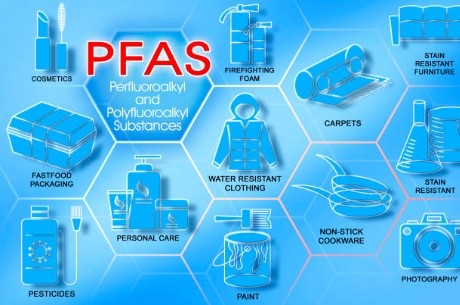PFAS – What it Means, Why we Care and What you can Do

Understanding the Basics
Per- and Polyfluoroalkyl Substances (PFAS) are a group of chemicals used to make fluoropolymer coatings and products that resist heat, oil, stains, grease, and water. Fluoropolymer coatings are blends of resins and lubricants used in products such as water-repellent clothing, furniture, adhesives, paint and varnish, food packaging, heat-resistant non-stick cooking surfaces and insulation of electrical wires.
Chemicals in this group include perfluorooctanoic acid (PFOA) and perfluorooctane sulfonic acid (PFOS).
Some PFAS do not break down easily and persist for a long time in the environment, especially in water. Their toxicity and persistence in the environment mean they are a potential danger to public health and the environment. Additional information on potential health impacts can be found in the NYS Regulatory Impact Statement, DOH Fact Sheet and Reducing PFAS in Private Wells.
I am on a Public Water System – Does it have PFAS in it?
Public water systems in New York must monitor for more than 100 different contaminants on a regular schedule, including PFOA, PFOS and 1,4-dioxane. Public water systems must report on all PFAS included in the analytical method when they detect any level of PFOA and PFOS. This helps identify additional unregulated PFAS contaminants that may be present.
Water systems must notify their local health department of any exceedances above state and/or federal standards. If there is a confirmed exceedance, the public water system will work with their local health department to notify the public and develop a course of action and timetable to reduce to acceptable levels.
In addition, Public Water Systems must also do an Annual Water Quality Report. The Annual Water Quality Report is designed to provide consumers with information on the quality of the water delivered by their public water system. Annual Water Quality Reports must contain information about the water system; information on the source of the water; reporting levels of contaminants detected in the finished water; information on cryptosoridium, radon, and other unregulated contaminants; information on any violations of the national primary drinking water regulations; and information regarding any variances or exemptions the water system may be operating under. Many times, these Annual Water Quality Reports are located on a website for easy access.
I have my own well, does it have PFAS in it?
The Westchester County Department of Health does not monitor private wells that are used for single family homes.
If you want to have your water tested you should use a certified lab.
Certified Laboratory Testing
New York State Certified Laboratories that are credentialed with the NYS Environmental Laboratory Approval Program (ELAP) should be the type of lab to conduct your analysis. These laboratories comply with strict guidelines for analysis where their results meet required Quality Assurance and Quality Control measures.
Go to NYS ELAP see a list of certified laboratories.
What can I do if I have a private well and I have elevated PFAS levels?
Some residents have asked about the use of in-home drinking water filtration units for reducing the amount of perfluorinated chemicals (PFAS) in drinking water. Water filtration units that use granulated activated carbon (GAC, also called charcoal filters) and reverse osmosis (RO) can be effective in removing these chemicals from water.
If you are installing a residential water filter to decrease levels of PFAS in your drinking water, you should always follow the manufacturer recommendations for when the filter should be changed. These units range from relatively inexpensive filtered water pitchers to larger systems. Read more about in-home water filtration options for household drinking water.
